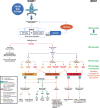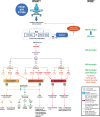Development of a New Care Pathway for Depression and Anxiety in Adult-Onset Isolated Dystonia
- PMID: 36949792
- PMCID: PMC10026302
- DOI: 10.1002/mdc3.13655
Development of a New Care Pathway for Depression and Anxiety in Adult-Onset Isolated Dystonia
Abstract
Background: Recently, we identified barriers and facilitators to the screening and treatment of depressive and anxiety symptoms in adult-onset isolated dystonia (AOID). These symptoms are common, functionally impairing, and often underdetected and undertreated.
Objectives: To develop a care pathway for mood symptoms in AOID.
Methods: We used a multistep modified Delphi approach to seek consensus among healthcare professionals with experience of AOID on the screening, diagnosis, and treatment of mood symptoms. A combination of face-to-face meetings and online surveys was performed from 2019 to 2020. We created the survey and then reviewed with stakeholders before 2 rounds of Delphi surveys, all of which was finally reviewed in a consensus meeting. A purposive sample of 41 expert stakeholders from 4 Canadian provinces, including neurologists, nurses, psychiatrists, psychologists, and family physicians, was identified by the research team.
Results: The Delphi process led to consensus on 12 statements that operationalized a pathway of care to screen for and manage depression and anxiety in people with AOID. Key actions of the pathway included yearly screening with self-rated instruments, multidisciplinary involvement in management involving local networks of providers coordinated by movement disorders neurologists, and access to educational resources. The Delphi panel indicated the 2 core steps as the documentation of the most recent screening outcome and the documentation of a management plan for patients who were positive at the last screening.
Conclusions: This new care pathway represents a potentially useful intervention that can be used to build an integrated model of care for AOID.
Keywords: anxiety; care pathway; depression; dystonia; management; screening.
© 2023 International Parkinson and Movement Disorder Society.
Figures


References
-
- Defazio G. The epidemiology of primary dystonia: current evidence and perspectives. Eur J Neurol 2010;17(Suppl 1):9–14. - PubMed
-
- Conte A, Berardelli I, Ferrazzano G, Pasquini M, Berardelli A, Fabbrini G. Non‐motor symptoms in patients with adult‐onset focal dystonia: Sensory and psychiatric disturbances. Parkinsonism Relat Disord 2016;22(Suppl 1):S111–S114. - PubMed
-
- Medina Escobar A, Pringsheim T, Goodarzi Z, Martino D. The prevalence of depression in adult onset idiopathic dystonia: Systematic review and metaanalysis. Neurosci Biobehav Rev 2021;125:221–230. - PubMed
LinkOut - more resources
Full Text Sources

